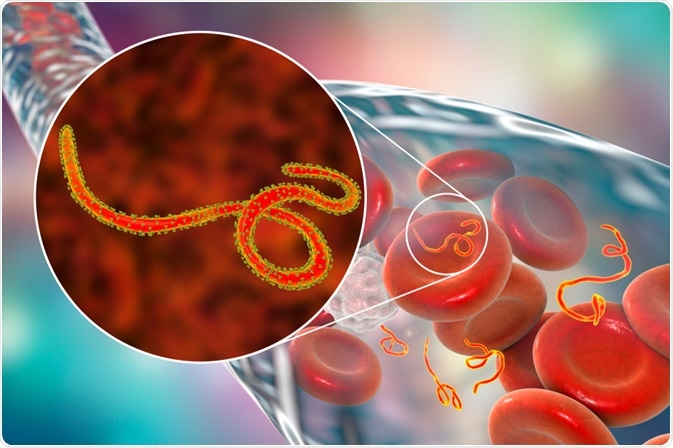Recurrent outbreaks of Ebola hemorrhagic fever in several countries of equatorial Africa have been noted in recent years. Along with the 2014 rampant outbreak, they occur in remote areas where advanced medical support systems are in short supply and timely diagnostic services are extremely difficult to provide.
In addition, there are a myriad of technical and logistical pitfalls concerning the launch of adequate diagnostic support, as these regions are burdened with cultural differences and occasionally hostile behavior. A supply of primary on-site diagnostics, including confounding differential diagnosis, may aid in the management of individual patients, as well as with the outbreak in general.
 Ebola virus in the blood of a patient with Ebola hemorrhagic fever. Image Credit: Kateryna Kon / Shutterstock.com
Ebola virus in the blood of a patient with Ebola hemorrhagic fever. Image Credit: Kateryna Kon / Shutterstock.com
Diagnostic algorithm for Ebola
Ebola hemorrhagic fever can be suspected in a person with a fever and a history of travel to an endemic area, although it is hard to pinpoint the exact cause based only on the early, non-specific symptoms. Acute and severe febrile diseases are represented with a wide range of causes in areas endemic for Ebola virus, with the most common being malaria and typhoid fever (and also Chikungunya, yellow fever, meningococcal septicemia, leptospirosis or relapsing fever).
If a person shows early symptoms of Ebola, and was in contact with a blood or bodily fluids of an infected patient or animal, isolation and notification of public health professionals are mandatory. Samples taken from the patient are then collected in order to confirm the infection by laboratory tests, usually carried out in national and international reference centers.
Laboratory diagnosis of Ebola is achieved in two ways: detection of infectious particles (or particle components) in affected individuals and measurement of specific immune responses to Ebola virus. Real-time polymerase chain reaction (RT-PCR) and ELISA antigen detection assay represent principal methods to diagnose an acute infection. Viral antigen and nucleic acid can be detected in blood from the third day of the disease.
For antibody detection, usually direct IgG and IgM ELISA and IgM capture ELISA are employed. IgM antibodies can appear two days upon onset of symptoms and last for several months. IgG-specific antibodies develop between day 6 and 18 after onset and persist for many years.
A finding of IgM positivity or a rising IgG titre represents a compelling presumptive evidence for the diagnosis of Ebola. On the other hand, decreasing IgM or a four-fold increase of IgG titres (and sometimes even both) in successive paired serum samples suggests a recent infection.
Only materials rendered non-infectious can be used for testing. Using heat inactivation or gamma irradiation from a radioisotope cobalt-60 source can efficiently inactivate the virus for antigen and antibody detection systems. Likewise, purification of the viral RNA for subsequent amplification is usually done from materials treated with guanidinium isothiocyanate (general protein denaturant).
Ebola 101 | National Geographic
Management of the disease
As no specific medicine has been proven effective against Ebola virus, current treatment strategies are principally symptomatic and supportive. In developing countries with low healthcare standards, these strategies include isolation, fluid substitution (preferably intravenously) and the addition of broad spectrum antibiotics, antipyretics and analgesics where needed.
Isolation of patients and the adherence to strict barrier nursing procedures (such as protective clothing and respirators) have successfully interrupted transmission in hospital settings in rural parts of Africa. Various methods to ensure barrier nursing, proper waste disposal and other pivotal components inexpensively and practically in Africa have been created, with available field-tested manuals.
In developed healthcare systems with adequate isolation units, appropriate intensive care treatment is advised and directed towards maintaining an effective blood volume, electrolyte balance and oxygen status. Serious complications such as renal failure, cerebral edema, coagulation disorders, secondary bacterial infection and shock have to be properly managed.
Apart from some experimental treatments in animals, no strategy has proved successful in treating Ebola virus infections in humans. Convalescent blood or serum for passive immunization has been used to treat the infected patients, but the success is controversial. A potential strategy might be to slow down viral replication and disease progression in order to allow both innate and adaptive immune responses to overcome the infection, as the immune system is central in surviving the Ebola.
References